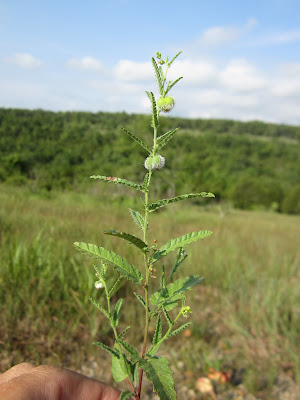Tragia ramosa: the spicy side of tactility

Ouch! Great Oden’s Raven!
This is what I exclaim moments before I locate Tragia ramosa while fingering my way through a quadrat or as I sit for lunch in an open glade with a view and decide to lay back and reflect. The nasty needlish and nettle-like hairs of this gangly dweller of grassland understories deftly prick the skin and give you a dose of hot proteinaceous exudate that, tingling as it burns, lasts for hours after the encounter. Try to avoid it as I may, I become hostage to Tragia’s maniacal “gotcha” game time and time again.
That being said, I am a big fan. It just has that lovable bulldoggish quality to it. And the fruits, how amazing are those bristly gynophorous brutes?

The complexity of Tragia’s pain delivery system is fascinating and has been intimately studied and explained by Thurston (1976). As explained by Thurston, each stinging “hair” is made up of four cells. Three of these cells are parallel to each other in an elongate fashion. The base of the triad is anchored to the leaf surface. The tips of the three cells converge around a terminal cell which is heavily vacuolated with stinging fluid. Protruding from the cell wall of the terminal “poison” cell is a fierce calcium oxalate crystal. But this is no ordinary crystal. The base of the crystal has several spikes that intrude into the interior of the terminal cell. The shaft of the crystal has a longitudinal groove all the way to the ice pick tip. The theory is that the slightest contact with the crystal causes the spikes at the base to rupture the vacuole and cytoplasm of the “poison” cell and the toxic brew is instantaneously funneled (or shot depending on the role of turgor pressure) into the skin of the offending beast. Tragia ramosa is covered with hundreds of thousands of such trigger happy hairs.
So where can those hungry for pain, those lusting for the spicy side of tactility experience this sneaky deterrent to sampler and grazer alike? Primarily a species of southwestern North America, Tragia ramosa enters the southern third of the Tallgrass Prairie Ecoregion at the northeastern extension of its range (BONAP). Here its range overlaps the similar Tragia betonicifolia.

In the photo above, taken at Tallgrass Prairie Preserve in the Flint Hills of Kansas, T. betonicifolia is on the left and T. ramosa on the right. Tragia betonicifolia has larger leaves on the lower half of the stem. These leaves are noticeably cordate as opposed to the nearly truncate leaf bases of T. ramosa. Also, the upper stem leaves of T. ramosa are narrower, thicker, hairier and more corrugated than those of T. betonicifolia.
So, be careful. Its dangerous out there. But if you find yourself face to face with a Tragia, feel free to give it a try. Chances are, it will find you first.
Thurston E.L. 1976. Morphology, fine structure and ontogeny of the stinging emergence of Tragia ramosa and T. saxicola (Euphorbiaceae). American Journal of Botany 63(6) 710-718.



This is really an interesting plant, and a fascinating post! I'm reminded of one of my favorite plants: Tribulus terrestris, Caltrop or Puncture Vine in the Zygophyllaceae.
ReplyDeleteGood stuff Justin, and great photos!
Hi Justin. I apologize, this is the only way I knew how to get a hold of you. I'd like to visit MO during spring break (mid-march). Wondering if you knew of any good spots around the state that are worth checking out. I'd like to see glades and as many Ozark-endemic ephemerals, communities, and landforms as possible. You can email me at m_whittemore2@yahoo.com
ReplyDeleteThank you!
Mike
Hahahahaha! I just came across this looking for an informative link to post on facebook, preceded by F*** you, Tragia. Do I get a chunk of your fat advertising checks if I help bump your page views? How's about you help me ID a pile of pressed Rubus spp instead.
ReplyDelete-Cody C